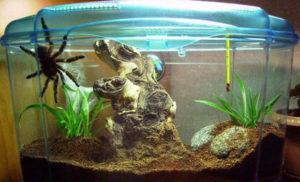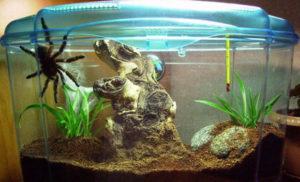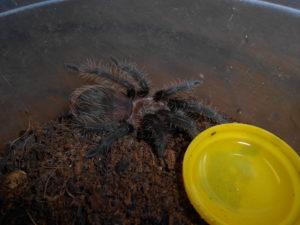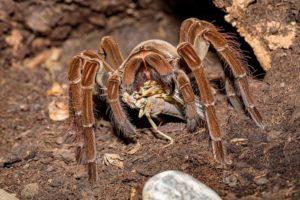Spider tarantula at home: growing rules
Cats and dogs will not surprise anyone. Reptiles, raccoons and monkeys live in people's houses. But often tarantulas become exotic pets in people's dwellings.
Content
Description of the spider
The tarantula is actually an active predator that feeds on insects and small arachnids. It captivates with its exotic appearance and nobility.
From the outside, the tarantula looks like a soft toy. It is big, fluffy and soft, and you just want to stroke or hold it in your arms. But the pet is not for the faint of heart and not for lovers of tenderness.
Domestic tarantula
There are no safe and non-venomous tarantulas. This is the basic rule to remember. There are only those species in which the degree of toxicity of the poison is slightly less.
There are species that have earned the love and respect of people for their beautiful appearance and demeanor.
Keeping a tarantula at home
To keep an exotic animal, you need to think about its comfort and your safety. There are three types of tarantulas depending on their lifestyle: terrestrial, arboreal and burrowing. Breeding rules are general.
Место жительствР°
The first thing you need to equip for a spider is a terrarium. The size is easily calculated by three full leg spans of an adult tarantula. The height depends on the species, from 20 to 30 cm.
Tree dwellers need to think about a place of deployment like a snag, and others should prepare some kind of cave for shelter. Burrowers will be happy to live in a thick layer of substrate or shelter underneath.
Substrate
The most important requirement is to pass air, maintain humidity. It is also important that it does not get moldy. It is best to use coconut soil, forest bark, for some decorative sand and jungle substrate.
But ordinary soil or one that is suitable for flowers cannot be used. They may contain chemicals or viruses, even parasites. Its layer depends on the species, from 2 cm to 5-7 cm.
Decoration and shelter
Living plants are not used, because they need light, which the tarantula does not need at all. The decor elements of the spider are not particularly interesting, the main thing is that they are not sharp and do not create obstacles for air circulation.
Tree and ground representatives need shelter. Special caves, parts of the bark and other piece parts of the dwelling are for sale. Just do not take the remains of stumps and bark from the street, in order to avoid infections and parasites.
Water
A sufficient amount of moisture is an important condition for the maintenance of tarantulas. It is necessary to use either a special drinker for insects, or a small cover, setting it against the wall.
It is also necessary to equip the terrarium with a hygrometer that will measure the level of humidity. If condensation appears on the walls or fungus on the substrate, it is necessary to immediately reduce the humidity.
Food
Tarantulas eat food that does not exceed half the size of its body. For feeding, live prey is placed in a terrarium with a spider and left so that it can hunt. For the faint of heart, this seems not quite a humane manifestation.
Having enough food is essential to your pet's health. But overeating is a problem, leading to rupture of the abdomen. The problem can be with large prey. If the spider cannot “overpower” her, she will cohabitate with him.
Stress
Some species of tarantulas are particularly susceptible to stress. For animals, the shock will be:
- moving;
- shake;
- a fall;
- disproportionate booty;
- bright light;
- lack of shelter.
If the stressful situation for the spider continues, it can start to get sick and die altogether.
Tenderness
People get pets to show feelings. A spider, especially such a beautiful and furry one, definitely wants to be touched and picked up. But it's better not to do this:
- There is a risk of being bitten.
- The spider can run away.
- The pet may accidentally fall, and this is fraught.
Some people pick up tarantulas. They teach pets from childhood and then they are less aggressive. If the spider combs the hairs, becomes in an aggressive pose or makes different sounds - it is frightened and defensive, it is better to leave it alone.
It can be picked up by gently pushing it into the palm of your hand, but nothing else.
Care
Cleaning your terrarium is extremely important. For this, the spider is removed, transplanted into special containers. They push him inside and clean up. The tarantula is carefully returned back without turning it over.
You also need to remove:
- remnants of uneaten food;
- his old skin that remained after molting.
Safe Operation
The most important thing when growing a spider is to follow a few safety rules.
- Choose a spider according to the level of training. Tarantulas have their own markings, from those suitable for growing by beginners, to those individuals that are only suitable for pros.
- Avoid abrupt changes in conditions of detention, flashes of light and excessive humidity.
- Be extremely careful when making contact, do not take the animal in and do not drop it.
How to choose a tarantula to keep at home
When an uninformed person starts choosing a spider, he may notice a big difference in price. It depends on a number of factors:
- type of tarantula;
- age;
- the gender of the pet;
- prevalence.
Conclusion
The tarantula is an amazing and unusual pet. He is busy with his fascinating affairs when he can be watched from the side. However, cultivation requires proper preparation and attitude, and most importantly, safety.
Previous




